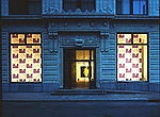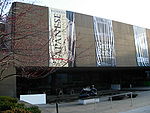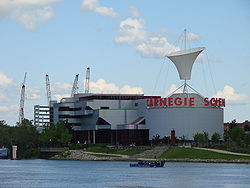
Carnegie Museums of Pittsburgh
Encyclopedia
Carnegie Museums of Pittsburgh are four museums that are operated by the Carnegie Institute headquartered in the Oakland
neighborhood of Pittsburgh, Pennsylvania
. Two of the Carnegie museums, the Carnegie Museum of Natural History
and the Carnegie Museum of Art
, are both located in the Carnegie Institute and Library complex in Oakland, a landmark building listed on the National Register of Historic Places
(ref #79002158, added 1979) that also houses the Carnegie Music Hall and the main branch of the Carnegie Library of Pittsburgh
. The other two museums, The Andy Warhol Museum
and the Carnegie Science Center
, are located in separate facilities on Pittsburgh's North Shore
.
Museum is the largest museum in the world dedicated to one artist. The museum's collection includes over 4,000 Warhol art works in all media
- painting
s, drawing
s, prints, photograph
s, sculpture
s, and installation
; the entire Andy Warhol Video Collection, 228 four minute Screen Tests
, and 45 other films by Warhol; and extensive archives, most notably Warhol's Time Capsules. While dedicated to Andy Warhol, the museum also hosts many exhibits by artists who push the boundaries of art, just as Warhol did.
 When Andrew Carnegie
When Andrew Carnegie
envisioned a museum collection consisting of the "Old Masters of tomorrow", the Carnegie Museum of Art became, arguably, the first museum of modern art
in the United States. Founded in 1895, today it continues Carnegie's love of contemporary art
by staging the Carnegie International
every few years. Numerous significant works from the Internationals have been acquired for museum's permanent collection including Winslow Homer
's The Wreck (1896) and James A. McNeill Whistler's Arrangement in Black: Portrait of Señor Pablo de Sarasate (1884). The marble
Hall of Sculpture replicates the interior of the Parthenon
. The Hall of Architecture contains the largest collection of plaster
casts of architectural masterpieces in America and one of the three largest in the world. The Heinz Architectural Center, opened as part of the museum in 1993, is dedicated to the collection, study, and exhibition of architectural drawings and models. In 2001 the museum acquired the archive of African-American photographer Charles "Teenie" Harris, consisting of approximately 80,000 photographic negatives spanning from the 1930s to the 1970s. Many of these images have been catalogued and digitized and are available online via the Carnegie Museum of Art
Collections Search.
The museum's permanent collection includes European and American decorative arts from the late seventeenth century to the present, works on paper, paintings, prints (notably Japanese prints), sculptures and installations.

From the discovery of Diplodocus carnegii to the most complete Tyrannosaurus rex known to date to a brand new, yet-to-be-named species of oviraptorosaur, Carnegie Museum of Natural History has one of the finest dinosaur
collections in the world. Other exhibits include Hillman Hall of Minerals and Gems
, Alcoa Foundation Hall of American Indians, Polar World: Wyckoff Hall of Arctic Life, Walton Hall of Ancient Egypt, and Benedum Hall of Geology. The museum's Powdermill Nature Reserve was established in 1956 to serve as a field station for long-term studies of natural populations, and now forms the core of the museum's Center for Biodiversity and Ecosystems. Research teams including Carnegie scientists have made critical discoveries such as Puijila darwini, Castorocauda lutrasimilis
, and Hadrocodium wui.

Opened in 1991, but with a history that dates to October 24, 1939, the Carnegie Science Center is the most visited museum in Pittsburgh. Among its attractions are the newly constructed Buhl Digital Dome (which features the latest in projection), the Rangos Omnimax Theater, SportsWorks
, the Miniature Railroad & Village
, and the USS Requin
, a World War II
submarine
.
Under the leadership of Robert Wilburn
, Buhl Science Center merged with the Carnegie Institute and a new $40 million Carnegie Science Center was constructed.
Video
Oakland (Pittsburgh)
Oakland is the academic, cultural, and healthcare center of Pittsburgh and is Pennsylvania's third largest "Downtown". Only Center City Philadelphia and Downtown Pittsburgh can claim more economic and social activity than Oakland...
neighborhood of Pittsburgh, Pennsylvania
Pennsylvania
The Commonwealth of Pennsylvania is a U.S. state that is located in the Northeastern and Mid-Atlantic regions of the United States. The state borders Delaware and Maryland to the south, West Virginia to the southwest, Ohio to the west, New York and Ontario, Canada, to the north, and New Jersey to...
. Two of the Carnegie museums, the Carnegie Museum of Natural History
Carnegie Museum of Natural History
Carnegie Museum of Natural History, located at 4400 Forbes Avenue in the Oakland neighborhood of Pittsburgh, Pennsylvania, USA, was founded by the Pittsburgh-based industrialist Andrew Carnegie in 1896...
and the Carnegie Museum of Art
Carnegie Museum of Art
The Carnegie Museum of Art, located in the Oakland neighborhood of Pittsburgh, Pennsylvania, is an art museum founded in 1895 by the Pittsburgh-based industrialist Andrew Carnegie...
, are both located in the Carnegie Institute and Library complex in Oakland, a landmark building listed on the National Register of Historic Places
National Register of Historic Places
The National Register of Historic Places is the United States government's official list of districts, sites, buildings, structures, and objects deemed worthy of preservation...
(ref #79002158, added 1979) that also houses the Carnegie Music Hall and the main branch of the Carnegie Library of Pittsburgh
Carnegie Library of Pittsburgh
The Carnegie Library of Pittsburgh is the public library system in Pittsburgh, Pennsylvania. Its main branch is located in the Oakland neighborhood of Pittsburgh, and it has 19 branch locations throughout the city...
. The other two museums, The Andy Warhol Museum
The Andy Warhol Museum
The Andy Warhol Museum, located on the North Shore of Pittsburgh, Pennsylvania, is the largest museum in the United States dedicated to a single artist...
and the Carnegie Science Center
Carnegie Science Center
The Carnegie Science Center, located in the Chateau neighborhood of Pittsburgh, Pennsylvania, opened in 1991.With a history that dates to October 24, 1939, the Carnegie Science Center is the most visited museum in Pittsburgh...
, are located in separate facilities on Pittsburgh's North Shore
North Shore (Pittsburgh)
The North Shore is a neighborhood in Pittsburgh, Pennsylvania's North Side. It has a zip code of 15212, and has representation on Pittsburgh City Council by both the council members for District 1 and 6...
.
Andy Warhol Museum
Opened on May 15, 1994, the Andy WarholAndy Warhol
Andrew Warhola , known as Andy Warhol, was an American painter, printmaker, and filmmaker who was a leading figure in the visual art movement known as pop art...
Museum is the largest museum in the world dedicated to one artist. The museum's collection includes over 4,000 Warhol art works in all media
Media (arts)
In the arts, a media or medium is a material used by an artist or designer to create a work.-Architecture:In the art and science of architecture, the design and construction of buildings and interiors, infrastructure and other physical structures are created...
- painting
Painting
Painting is the practice of applying paint, pigment, color or other medium to a surface . The application of the medium is commonly applied to the base with a brush but other objects can be used. In art, the term painting describes both the act and the result of the action. However, painting is...
s, drawing
Drawing
Drawing is a form of visual art that makes use of any number of drawing instruments to mark a two-dimensional medium. Common instruments include graphite pencils, pen and ink, inked brushes, wax color pencils, crayons, charcoal, chalk, pastels, markers, styluses, and various metals .An artist who...
s, prints, photograph
Photograph
A photograph is an image created by light falling on a light-sensitive surface, usually photographic film or an electronic imager such as a CCD or a CMOS chip. Most photographs are created using a camera, which uses a lens to focus the scene's visible wavelengths of light into a reproduction of...
s, sculpture
Sculpture
Sculpture is three-dimensional artwork created by shaping or combining hard materials—typically stone such as marble—or metal, glass, or wood. Softer materials can also be used, such as clay, textiles, plastics, polymers and softer metals...
s, and installation
Installation art
Installation art describes an artistic genre of three-dimensional works that are often site-specific and designed to transform the perception of a space. Generally, the term is applied to interior spaces, whereas exterior interventions are often called Land art; however, the boundaries between...
; the entire Andy Warhol Video Collection, 228 four minute Screen Tests
Screen Tests
Andy Warhol's Screen Tests are a series of silent film portraits consisting of several-minute unbroken shots of Factory regulars, Warhol superstars, celebrities, guests, friends, or anyone he thought had "star potential".-Production background:...
, and 45 other films by Warhol; and extensive archives, most notably Warhol's Time Capsules. While dedicated to Andy Warhol, the museum also hosts many exhibits by artists who push the boundaries of art, just as Warhol did.
Carnegie Museum of Art

Andrew Carnegie
Andrew Carnegie was a Scottish-American industrialist, businessman, and entrepreneur who led the enormous expansion of the American steel industry in the late 19th century...
envisioned a museum collection consisting of the "Old Masters of tomorrow", the Carnegie Museum of Art became, arguably, the first museum of modern art
Modern art
Modern art includes artistic works produced during the period extending roughly from the 1860s to the 1970s, and denotes the style and philosophy of the art produced during that era. The term is usually associated with art in which the traditions of the past have been thrown aside in a spirit of...
in the United States. Founded in 1895, today it continues Carnegie's love of contemporary art
Contemporary art
Contemporary art can be defined variously as art produced at this present point in time or art produced since World War II. The definition of the word contemporary would support the first view, but museums of contemporary art commonly define their collections as consisting of art produced...
by staging the Carnegie International
Carnegie International
The Carnegie International is the oldest North American exhibition of contemporary art from around the globe. It was first organized at the behest of industrialist and philanthropist Andrew Carnegie on November 5, 1896 in Pittsburgh. Carnegie established the International to educate and inspire the...
every few years. Numerous significant works from the Internationals have been acquired for museum's permanent collection including Winslow Homer
Winslow Homer
Winslow Homer was an American landscape painter and printmaker, best known for his marine subjects. He is considered one of the foremost painters in 19th century America and a preeminent figure in American art....
's The Wreck (1896) and James A. McNeill Whistler's Arrangement in Black: Portrait of Señor Pablo de Sarasate (1884). The marble
Marble
Marble is a metamorphic rock composed of recrystallized carbonate minerals, most commonly calcite or dolomite.Geologists use the term "marble" to refer to metamorphosed limestone; however stonemasons use the term more broadly to encompass unmetamorphosed limestone.Marble is commonly used for...
Hall of Sculpture replicates the interior of the Parthenon
Parthenon
The Parthenon is a temple on the Athenian Acropolis, Greece, dedicated to the Greek goddess Athena, whom the people of Athens considered their virgin patron. Its construction began in 447 BC when the Athenian Empire was at the height of its power. It was completed in 438 BC, although...
. The Hall of Architecture contains the largest collection of plaster
Plaster
Plaster is a building material used for coating walls and ceilings. Plaster starts as a dry powder similar to mortar or cement and like those materials it is mixed with water to form a paste which liberates heat and then hardens. Unlike mortar and cement, plaster remains quite soft after setting,...
casts of architectural masterpieces in America and one of the three largest in the world. The Heinz Architectural Center, opened as part of the museum in 1993, is dedicated to the collection, study, and exhibition of architectural drawings and models. In 2001 the museum acquired the archive of African-American photographer Charles "Teenie" Harris, consisting of approximately 80,000 photographic negatives spanning from the 1930s to the 1970s. Many of these images have been catalogued and digitized and are available online via the Carnegie Museum of Art
Carnegie Museum of Art
The Carnegie Museum of Art, located in the Oakland neighborhood of Pittsburgh, Pennsylvania, is an art museum founded in 1895 by the Pittsburgh-based industrialist Andrew Carnegie...
Collections Search.
The museum's permanent collection includes European and American decorative arts from the late seventeenth century to the present, works on paper, paintings, prints (notably Japanese prints), sculptures and installations.
Carnegie Museum of Natural History

From the discovery of Diplodocus carnegii to the most complete Tyrannosaurus rex known to date to a brand new, yet-to-be-named species of oviraptorosaur, Carnegie Museum of Natural History has one of the finest dinosaur
Dinosaur
Dinosaurs are a diverse group of animals of the clade and superorder Dinosauria. They were the dominant terrestrial vertebrates for over 160 million years, from the late Triassic period until the end of the Cretaceous , when the Cretaceous–Paleogene extinction event led to the extinction of...
collections in the world. Other exhibits include Hillman Hall of Minerals and Gems
Hillman Hall of Minerals and Gems
The Hillman Hall of Minerals and Gems is a notable mineral and gem collection within the Carnegie Museum of Natural History in Pittsburgh, Pennsylvania....
, Alcoa Foundation Hall of American Indians, Polar World: Wyckoff Hall of Arctic Life, Walton Hall of Ancient Egypt, and Benedum Hall of Geology. The museum's Powdermill Nature Reserve was established in 1956 to serve as a field station for long-term studies of natural populations, and now forms the core of the museum's Center for Biodiversity and Ecosystems. Research teams including Carnegie scientists have made critical discoveries such as Puijila darwini, Castorocauda lutrasimilis
Castorocauda lutrasimilis
Castorocauda was a genus of small, semi-aquatic relative of mammals living in the mid Jurassic period, around 154 million years ago, found in lakebed sediments of the Daohugou Beds of Inner Mongolia...
, and Hadrocodium wui.
Carnegie Science Center

Opened in 1991, but with a history that dates to October 24, 1939, the Carnegie Science Center is the most visited museum in Pittsburgh. Among its attractions are the newly constructed Buhl Digital Dome (which features the latest in projection), the Rangos Omnimax Theater, SportsWorks
UPMC SportsWorks
Highmark SportsWorks is one of the major, consistent exhibits of the Carnegie Science Center located in Pittsburgh, Pennsylvania. It is one of largest science and sports exhibition in the world, with over 30 interactive experiences in which visitors can participate...
, the Miniature Railroad & Village
Miniature Railroad & Village
The Miniature Railroad & Village is one of the largest and most detailed model train layouts in the United States. It painstakingly shows how Western Pennsylvania was from 1880 to 1930...
, and the USS Requin
USS Requin (SS-481)
USS Requin , a Tench-class submarine, was the only ship of the United States Navy to be named for the requin, a sand shark. Her name was pronounced by her crew....
, a World War II
World War II
World War II, or the Second World War , was a global conflict lasting from 1939 to 1945, involving most of the world's nations—including all of the great powers—eventually forming two opposing military alliances: the Allies and the Axis...
submarine
Submarine
A submarine is a watercraft capable of independent operation below the surface of the water. It differs from a submersible, which has more limited underwater capability...
.
Under the leadership of Robert Wilburn
Robert Wilburn
Robert C. Wilburn is the director of Carnegie Mellon University Heinz College's Washington, DC campus as well as a Distinguished Service Professor at the college. Prior to this position he was the first president and Chief Executive Officer of the Gettysburg Foundation...
, Buhl Science Center merged with the Carnegie Institute and a new $40 million Carnegie Science Center was constructed.
External links
- Carnegie Museums of Pittsburgh
- Andy Warhol Museum
- Carnegie Museum of Art
- Carnegie Museum of Natural History
- Carnegie Science Center
- Powdermill Nature Reserve
Video

